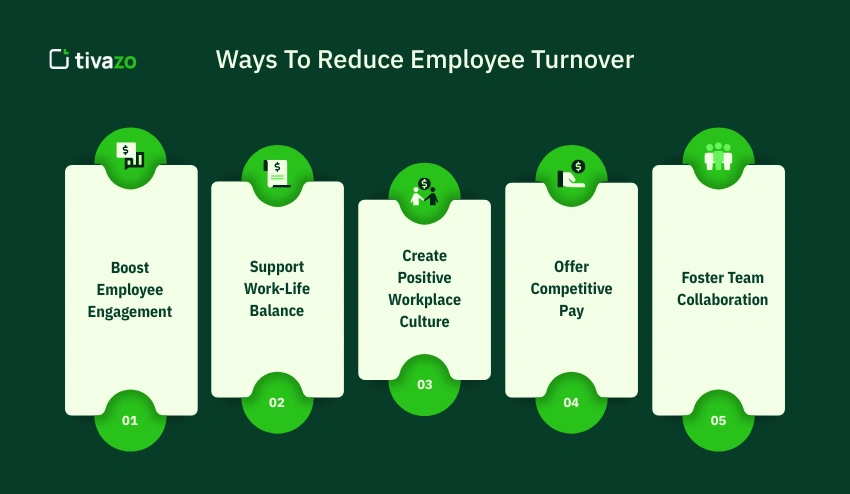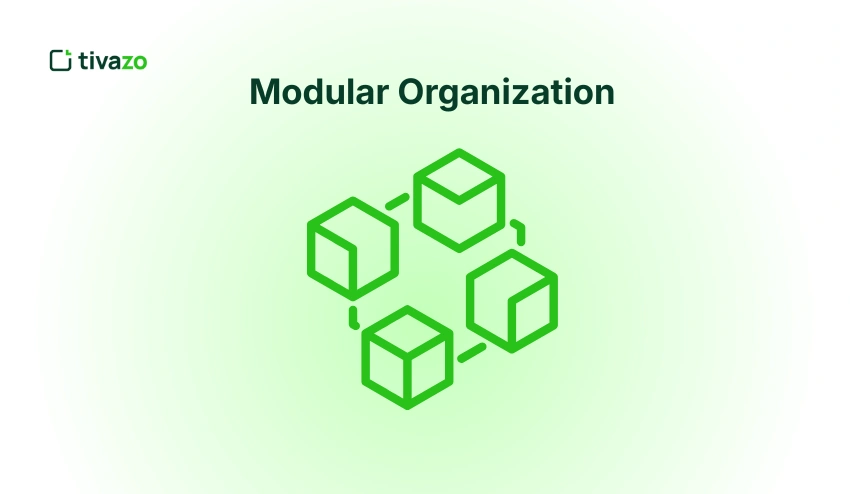Losing hardworking employees can be painful since it seems that you are watching your efforts being walked away by your company. Each exit is a waste of time, money, and morale.
Learning how to reduce employee turnover is important in creating a consistent, hardworking workforce. High turnover not only influences your operations, but it can also damage your company culture and image.
Luckily, strategies have been proven useful to address this challenge. Employee participation, career development, recognition, and a favorable work atmosphere will help businesses to retain the most talented workers and reduce turnover. In this blog, we will discuss practical measures on how to reduce employee turnover, job satisfaction, and employee loyalty so that your organization can continue to be healthy, competitive, and capable of achieving long-term success.
👉You May Also Like: What Are The Top 10 Reasons For Employee Turnover
10 Proven Ways To Reduce Employee Turnover
Employee turnover can be very disruptive and resource-intensive; thus, it is important to be acquainted with effective strategies. Knowledge on how to reduce employee turnover enables businesses to keep talent, enhance morale, and enhance overall performance.

1. Boost Employee Engagement
Engaged employees tend to stay longer in an organisation, hence engagement stands as one of the determinants of low turnover. To learn how to reduce employee turnover, you have to first know what motivates your team. Regular surveys, meaningful work, and open communication should be encouraged to ensure the employees remain involved.
Engagement also involves acknowledging a success and making small wins. When they feel appreciated, the employees will be more devoted to the success of the company. Such appreciation is one of the fundamental tactics on how to decrease employee turnover.
Lastly, offer chances to work in teams and provide feedback. Employees will get loyalty when they see their ideas are implemented. The focus on engagement directly influences how to reduce employee turnover.
2. Offer Career Growth
Career development is essential because employees will exit the company when they have no growth opportunities. Training programs and mentorships are also necessary steps in how to reduce employee turnover.
Frequent performance appraisals and individual development plans provide staff with direction on their career. The long-term relationship that is reflected in this investment is essential in minimizing turnover.
Talent should be motivated by offering certifications, training, and the development of skills. Employees have the ability to develop professionally, and this enhances retention and directly answers the question of how to reduce employee turnover.
3. Support Work-Life Balance
The work-life balance is important because a large number of employees leave their jobs because of burnout. One of the effective methods to address this issue and understand how to reduce employee turnover is flexible schedules, the option of remote working, and wellness.
It is advisable to promote breaks such as a pomodoro break, time off, and workable workloads in eliminating stress. When employees feel that they are allowed to have a balanced work and personal life, then they will be in a position to remain long-term.
Increased productivity and morale also come with the promotion of a culture of valuing personal time. Obsession with work-life balance is an effective strategy in how to reduce employee turnover.
4. Recognize Achievements
Rewards encourage the employees and alleviate the perceived undervaluation. The key component in how to reduce employee turnover is having a strong reward system.
Congratulations on every achievement, whether spoken or in the form of a reward, which makes morale high. Feeling valued makes employees more loyal and motivated.
Rewards are better tailored to individual tastes, e.g., bonuses, gift cards, or public recognition, which even further enhances retention. Recognition should be prioritized in line with the strategies on how to reduce employee turnover.
5. Create a Positive Workplace Culture
Work can be toxic or disengaging to the employees, and they are pushed away. One of the ways that help in knowing how to reduce employee turnover is by building a positive work culture.
Promote respect, inclusivity, and collaboration across teams. Promote openness and be a role model to leadership.
A supportive culture reduces conflict and fosters loyalty. Retention is enhanced when workers feel secure and honored, so culture is one of the essential parts of how to reduce employee turnover.
6. Offer Competitive Pay
Employees with low pay tend to move, and therefore, adequate remuneration is necessary. Conducting regular reviews of salaries is also a viable measure in the process of how to reduce employee turnover.
Provide competitive advantages, such as health insurance, retirement, and bonuses. This will make the employees feel that their input is given financial recognition.
Open pay systems create trust and minimise turnover. Companies that invest in fair pay directly address how to reduce employee turnover.
7. Strengthen Onboarding Programs
The poor onboarding experience can leave employees lost and unprepared. A good onboarding strategy assists in how to reduce employee turnover during the first days.
Provide clear expectations, training, and mentorship for new hires. When employees know their role and the company culture, they will be more engaged.
Good onboarding creates confidence and loyalty. This step has a great influence on how to reduce employee turnover.
8. Encourage Open Communication
The absence of communication may result in confusion and discontent. Open communication is an important element in the communication of how to reduce employee turnover.
Frequent check-ins, feedback, and suggestions channels will enable the employees to express concerns. Trust and engagement are supported by management responsiveness.

Transparent communication strengthens relationships and reduces unnecessary departures. This is one of the fundamental aspects of how to reduce employee turnover.
9. Foster Team Collaboration
The employees would be willing to remain when they feel part of a team. The strategy to encourage collaboration is a good strategy to adopt on how to reduce employee turnover.
Arrange group building exercises, cross-departmental projects, and goal setting together. This enhances fellowship and a sense of belonging.
Loyalty is developed when employees are united with their fellow employees and the organization’s mission. Teamwork-oriented approaches play a crucial role in how to reduce employee turnover.
10. Act on Feedback
It is important to know the reasons employees leave in order to prevent employee turnover. The exit interviews are used to provide information on how to reduce employee turnover.
Determine trends in feedback to pinpoint system-wide problems, such as management concerns or workload problems. Acting on such findings demonstrates to the employees that their opinions count.
Retention is enhanced by continuous improvement of feedback. Firms that learn through exit are in a better place to minimize turnover, and this is a crucial move in how to reduce employee turnover.
These 10 tips can help make your workplace interesting and positive to work in. With these approaches in mind, you can work greatly on retention and learn how to reduce employee turnover in your company.
How to reduce employee turnover in healthcare?
The issue of employee turnover in healthcare requires mitigation since a high rate of turnover may jeopardize patient care, raise the cost of operations, and affect the dynamics of teams. To comprehend the possibilities of how to reduce employee turnover in healthcare, it is necessary to combine strategic management, employee support, and workplace improvements that will address the peculiarities of the sphere.
Employee engagement is one of the best methods to be used effectively. Much less likely to leave are healthcare professionals who feel valued, heard, and supported. Professional development opportunities, continuing education, and well-defined career paths not only increase morale but also enhance retention, which directly answers how to reduce employee turnover in healthcare.
Another essential consideration is the work-life balance. The healthcare employees tend to work long hours and under pressure, thus flexible scheduling, wellness, and staffing are important. Rewarding performance, offering good remuneration packages, and a favorable working environment also increase loyalty.
These measures would help healthcare organizations to increase employee satisfaction, better care provision to patients, and manage effectively how to reduce employee turnover in healthcare.
How to reduce employee turnover in manufacturing?
Employee turnover in manufacturing may alter the production schedule, raise the expenses, and impact the efficiency. Knowledge on how to reduce employee turnover in manufacturing will be important in ensuring that there is a stable, skilled workforce.

1. Ensure Competitive Pay and Benefits
Compensation and benefits of fairness are central to retention. An important part of how to reduce employee turnover in manufacturing is to review wages and provide bonuses, health benefits, and incentives.
Workers who are adequately paid become loyal and motivated. Open pay scales and rewards reflect value, thus they are unlikely to jump ship.
2. Foster Safety and Work-Life Balance
Safe work environment and balanced schedules are very important in curbing turnover. One of the effective measures in the way to reduce employee turnover in manufacturing is placing safety measures and wellness programs first.
Flexible work schedules and adequate rest time reduce stress and burnout. When employees have a sense of security and support, they also have a higher chance of remaining, therefore increasing retention.
3. Recognize Employee Contributions
Recognition motivates employees and reinforces loyalty. Rewarding the efforts needs to be done on a regular basis in the context of reducing employee turnover in manufacturing.
The little gestures, such as verbal compliments, trophies, or employee-of-the-month programs, raise morale. Employees will be motivated to stay in the company by feeling appreciated.
Through the strategies applied in practice, manufacturers are able to retain talent, enhance productivity, and reinforce the company culture. These approaches would ensure the company is successful in the long term and will discuss the issue of decreasing employee turnover in production.
What are the 3 R’s of employee retention?
The 3 R’s of employee retention is a lean model applied by HR and management to minimize turnover and retain employees. They are:
- Recruitment – To find the ideal candidates that match the organization’s culture and job. The best recruitment process gives the employee higher chances of staying in the long run.
- Retention – The application of measures to retain employees by making them engaged, satisfied, and motivated. These are acknowledgment, career development, remuneration, work-life balance, and a favorable working atmosphere.
- Recognition – Rewarding and rewarding employees for their contribution. Recognition levels boost morale, loyalty, and job satisfaction, and they tend to stay longer.
The combination of these three R’s creates a cycle: identify the right talent, keep them engaged with good practices, and reward their efforts to enhance engagement and minimise turnover.
Is 42% of employee turnover preventable?
Yes, studies indicate that about 42% percent of the turnover rate among employees can be avoided, i.e., strategic actions can be undertaken by companies to retain their talent. It is important to know how to reduce employee turnover rates since most of them leave due to various reasons, such as a lack of engagement, career advancement, job appreciation, or poor work-life balance.
By targeting these aspects, businesses will be able to make work more supportive and motivating. Such strategies, as competitive wages, employee development initiatives, and positive working climate, directly influence how to reduce employee turnover issues; thus, it is possible to avoid almost half of all the resignations.
Conclusion
Minimizing staff turnover is the only way to keep the workforce productive, engaged, and loyal. Businesses can manage the question of how to reduce turnover of employees effectively by adopting strategies that will allow them to increase engagement, provide career development, acknowledge performance, and provide a good workplace culture. By concentrating on these best practices, not only will retention increase, but also the performance, morale, and future success of the company.




